Product Description:
Porosiscope-Plus™
The field test
for air and water permeability of concrete using the
Figg technique.
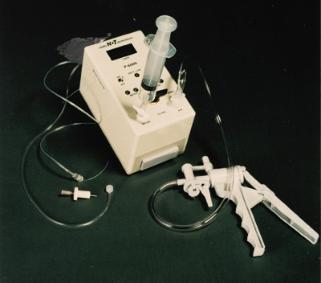
-
Both air and water permeability are measured by the same instrument.
-
Permeability
both at the concrete surface
as well as within the concrete mass can be determined.
-
Porosity in
sealants and surface mortars can be checked.
-
The test is non-destructive (only a
small
plugged
hole required) and can be completely
carried
out on site.
-
Each test can
be completed in only a few minutes and gives reliable reproducible
results.
-
The test
enables meaningful concrete durability predictions to be made.
Tests the air
and water permeability of concrete - at the surface and beneath
Porosiscope Plus™
measures the time it takes for air to flow into a
known volume of a sealed, evacuated chamber in the concrete. While the
vacuum reduces from
-55
Kpa to -50 Kpa, a measure of air permeability is
determined. For water permeability,
porosiscope Plus™
uses the same chamber filled with water, and measures the total time in
seconds for a volume of 0.01 ml of water to escape. Surface porosity is
determined in like manner using a specially designed surface chamber.
Internal Test:
A
hole 10 mm diameter x 40 mm deep is
drilled and plugged leaving a cylindrical test void 10 mm diameter x 20
mm high situated 20 mm below the concrete surface. The time required
for air and water to permeate through the test material to the void is
used as an index to determine the quality of the con
crete under test.
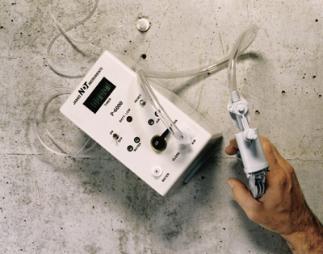
Air Permeability:
The
air permeability test is always done first since moisture has a large
effect on permeability. Connect the air outlet tube on the instrument
to the
Luer connector on
the top of the hypodermic needle. Connect the hand operated vacuum pump
to the air connection on the top of the instrument and evacuate to
greater than 55
kPa. The instrument timer and
manometer will automatically show the time in seconds for the vacuum to
fall from a 55
kPa to a 50 kPa. This time is the Figg number and is a measure of the air
permeability of the concrete.
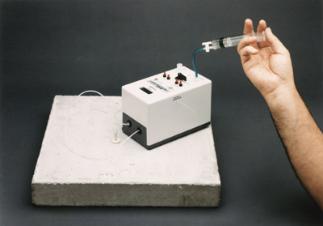
Water
Permeability
:
Connect
the water outlet tube to the
Luer socket on the top of the
hypodermic and ensure that the fine plastic inner tube is
of sufficient length to reach the bottom of the test cavity. After
filling the syringe with distilled water connect it to the water inlet
on top of the instrument. The water is then forced into the cavity and
the air displaced out through the outer tube through the overflow tube
which is 4 inches (100 mm) above the surface of the concrete. The
cavity
is filled when water starts to flow out the overflow tube. The
instrument flow sensor and timer then automatically measures the time
taken for the water meniscus to travel a distance of 50 mm and this
time
in seconds is displayed on the LCD display of the instrument. The time
in seconds is the
Figg number for water permeability.
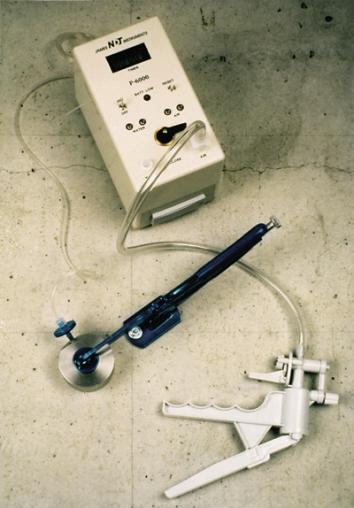
Surface
Permeability Test
:
Measurements are carried out at the
surface by clamping a stainless steel chamber on the smooth surface of
the concrete. An exactly dimensioned cup grinding wheel is used to
smooth the sealing surface of the concrete if necessary. A measurement
of the time required
for related amounts of air and water to permeate through the concrete
is used as an index of the surface conditions. This time can then be
used to determine the condition of any concrete sealant or surface
mortar.
Surface Test
Details
:
A stainless steel surface chamber
with the same surface area and exactly twice the volume of the hole
used in the internal test is now used as the void for this test.
The method of sealing the surface
chamber to the concrete eliminates the possibility of variation in the
test due to sealants seeping into the chamber, or voids along the
sealing surface. The surface chamber is sealed to the concrete by
grinding a smooth donut in the surface with the cup wheel provided.
This
cup wheel is sized to exactly match the dimensions of the surface
chamber. A pair of o-rings mounted concentrically in the surface
testers' flange is then used to seal the chamber to the surface. The
two
o-rings eliminate the possibility of a surface void in the material
being tested defeating the test. After clamping the surface chamber to
the surface a strong seal is now provided with no variation in volume.
This surface chamber is now used as
the void for testing porosity of the surface. Rather than the walls of
the hole being the tested surface the surface that the chamber is
sealed against is now the surface tested. This provides a check for
water and air penetration through concrete sealants, surface mortars
and
any other methods used to seal construction material surfaces.
The
surface chamber has been designed to easily accommodate attachment to
the instrumentation. By first performing the air test as outlined in
the internal test and then the water test the instrumentation will
provide the time required for the chamber to lose 5
kPa vacuum or once filled with water, 0.01 ml
water.
With
the surface tester attached to the instrument both a
Figg number and direct indices for air
and water surface permeability can be established.
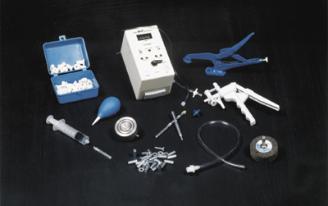
The
ingress of air and moisture into the concrete can cause corrosion of
the steel reinforcement and lead to a deterioration in concrete
strength. Therefore, a measure of the ease of movement of liquids and
gases through the surface layer of the concrete is a better method of
assessing the soundness and expected life of concrete than strength
alone. Permeability is recognized as being the most important parameter
in assessing concrete durability.
The
air permeability test involves measuring the time taken for air to flow
into a known volume of a sealed, evacuated chamber in the concrete,
reducing the vacuum from -55
kPa to -50 kPa. This time is a measure of the air
permeability of the concrete.
The water permeability test
utilizes the same sealed chamber in the concrete which is completely
filled with water and the total time in seconds for a volume of 0.01 ml
of water to escape is taken as a measure of the water permeability of
the concrete.
The moisture content of the
concrete has a
major effect on permeability. For example, fully saturated concrete is
almost impermeable to air and results in extremely long times in the
water permeability test.
For effective
testing the concrete should be dry and the near surface moisture
content measured. Permeability test results have show that there is a
good correlation with both water/cement ratio and compressive strength
of the concrete.
|
Weight,
complete in carrying case
|
12.0 lbs.
(5.4kg)
|
|
Dimensions
|
17 x 12 x 6 inches (43 x 30 x
15 cm
)
|
|
Power
Supply
|
Standard
9V Battery
|
|
Grinding
Wheel Rpm
|
12000 max
|
|
Measurement
accuracy
|
1 second
|
|
Operating
temperature
|
1° to 35° c
|
|
Pressure
|
-55kPa to -50kPa
|
|
Water
Volume
|
0.01 mL
|
Downloadable Instruction Manual
| 




